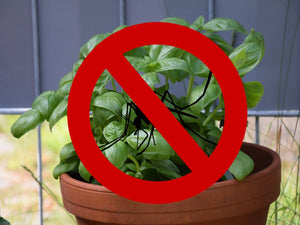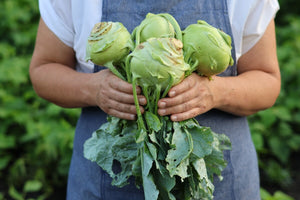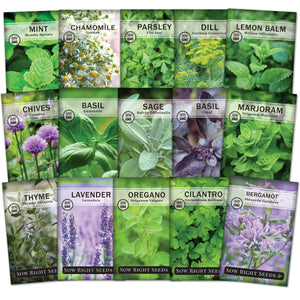Grow Thai Basil From Seed for an Abundant Harvest With Premium Taste!
Herb growing tipsIf you're a fan of Thai cuisine, consider growing your own Thai basil. This herb has a unique flavor profile that sets it apart from other types of basil, with a spicy kick and hints of licorice or anise. Luckily, growing Thai basil from seed is a simple process that anyone can do. With just a few easy steps, you can have a steady supply of this delicious herb right at your fingertips.

How to Grow Thai Basil From Seed
Thai Basil (Ocimum basilicum) is a beautiful basil that produces large green leaves with dark purple stems and flowers. The distinct taste is different from Sweet Basil and Holy Basil. But like other basil plants, Thai Basil is easy to grow from seed. If you want a steady supply of Thai Basil, follow these easy steps to start growing from seed.
Thai basil is a tender annual that does not tolerate cold temperatures. However, it will grow well in sunny locations with rich soil.
- Thai basil seeds can be directly sown outdoors after the danger of frost is passed and the soil temperature is 70ºF.
Choose a location that receives full sun, which means at least 6 to 8 hours of direct sunlight each day.
Plant Thai basil in soil that is nutrient-rich and loamy. The soil should be able to hold moisture and drain well.
Tips for Fail-proof Thai Basil Seed Germination
Starting Thai Basil seeds indoors will give you the best germination rates.
Start Thai basil seeds indoors 6 to 8 weeks before the last spring frost.
Place Thai basil seeds in seed starting trays or pots and plant 1/4” deep.
A soil temperature of 70 to 85ºF is optimal for seed germination.
Water by misting until the seeds start to sprout.
Use a humidity dome or cover to keep the seeds moist and prevent them from drying out.
Thai basil seeds should start sprouting in 5 to 14 days.
Once the basil seedlings are growing, water from the bottom to avoid damping off.
Thin out your seedlings once they have sprouted. Keep the largest and strongest to grow without competition. For more information, read about thinning seedlings.
How to Grow Thai Basil Plants
Once the basil plants are several inches tall and have at least two true leaves, they will be ready for transplanting outside.
Start by hardening off your Thai Basil seedlings so they will thrive in their new location. Hardening off is an important step that will ensure transplanting success. First, place the seedlings outside in a spot sheltered from intense heat or wind for 1 hour. Then increase the time by an hour each day. You can read more detailed information about how to harden off seedlings in our Planter’s Library.
Make sure all danger of frost is passed before permanently moving your Thai Basil seedlings outdoors. Temperatures should be at least 70ºF. In the winter, plants will die off when temperatures drop below 40ºF.
Space the Thai Basil plants 12 to 18 inches apart. Giving them room to grow will allow for good air circulation, and their roots won’t be competing for nutrients.
When transplanting, make sure not to cover up the base of the seedling with soil. Plant only to the depth of which it was already growing.
Choose a location with full sun. At least 6 to 8 hours a day. These green leaves love to capture the light.
When planting Thai Basil in your garden, put it near plants with similar light and water requirements. If you have an herb garden, basil plants will fit right in next to your chamomile and oregano. Basil can also be added to a flower bed. It will help repel insects and can be used in flower arrangements.
A rich loamy soil is best for growing Thai Basil. Putting compost in the soil before transplanting will provide the necessary nutrients.
Watering Thai Basil
Basil prefers moist soil that drains well. Consistent watering of about 1 ½ inches a week should be sufficient. If growing basil in containers, more frequent watering may be necessary to prevent the roots from drying out. Be careful of overwatering. When roots remain too wet, they will become waterlogged, and the plant will turn yellow and eventually die.
Fertilizing Thai Basil
Like other herbs, Thai Basil doesn’t need much fertilizer, but it does benefit from nitrogen for leaf growth. Adding organic matter, such as compost, to your garden beds before transplanting can help supplement the additional nutrients your plants need as they grow. If fertilizer is necessary, use a balanced fertilizer every 3 to 6 weeks at half strength.

Solutions for Thai Basil Pests and Diseases
Basil makes a great companion plant because it naturally repels so many pests.
For vigorous, healthy plants, keep weeds out so the Thai Basil doesn't have to compete for nutrients.
Keeping the soil moist but not too wet will prevent root rot.
Pruning and Harvesting Thai Basil
Pruning and harvesting Thai Basil are almost the same thing. And if you harvest with a pruning focus, you will encourage more plant growth and prevent your basil from going to seed.
You can start harvesting basil leaves once your Thai basil plant has 6 to 8 true leaves.
At first, just take a few leaves. Once the plant is large enough, you can harvest whole stems.
Cutting just above a leaf node will encourage branching, and you’ll have a bushier, more compact basil plant. Within a week of cutting, you will see new growth.
To keep Thai Basil growing, always snip off flowers before they have a chance to bloom. If you allow the flowers to grow and go to seed, the basil leaves will develop a bitter taste. You may need to snip the flower stem below a leaf node to keep that stem from developing more flowers. This will allow the plant to continue to produce the tastiest leaves.
A pair of sharp kitchen shears is a helpful tool for herb harvesting and pruning.
Harvesting Thai basil is an important part of helping your plants grow. Thai Basil will grow better if it is pruned or harvested regularly. Each time you cut off a branch, another one will start growing.
Storing Thai Basil
If you can’t use it fast enough, you can always dry Thai Basil. To dry basil, cut stems and hang them where they can have good air circulation away from direct sunlight.
Dried basil can be stored in airtight containers away from heat and light. It will last for about a year.
FAQs about Thai Basil
Can I grow Thai Basil indoors?
Basil needs plenty of light. With a good light source, you can grow Thai basil indoors. For every required hour of sunlight that it doesn’t get indoors, supplement with grow lights for 2 hours. For even more specifics, read our blog on growing herbs indoors.
Does Thai Basil grow in containers?
Growing Thai Basil in a pot on your patio is a convenient way to always have it on hand. It will be a beautiful plant and grow well as long as it has sufficient light and water. The soil needs to stay moist and not too dry or too wet.
What does Thai Basil taste like?
Thai basil is spicy with a licorice or anise flavor. Distinctly different from sweet basil.
Grow Thai basil in Your Garden!
Growing Thai Basil from seed is easy to do and so rewarding. You can add it to your herb, vegetable, and flower gardens. If you do let it go to seed, it will attract beneficial pollinators for the rest of your garden.
Start growing Thai Basil to have a steady supply for all your favorite recipes.
Happy Growing!











Leave a comment